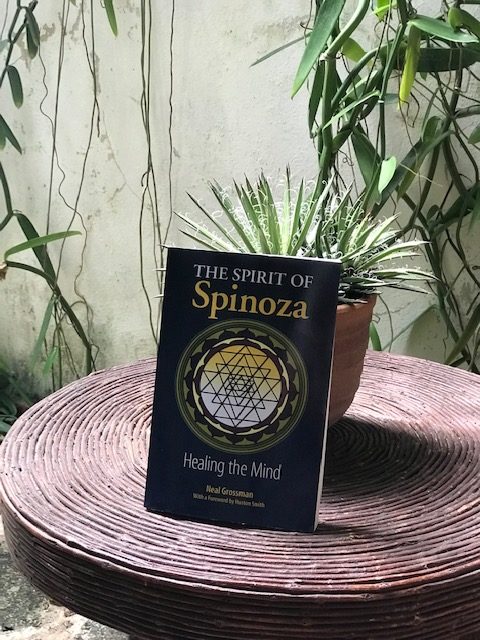
THE SPIRIT OF SPINOZA: Healing the Mind by Neal Grossman
As a reader, I’m a corner-folder, placing tiny checkmarks √ and marginalia in my books, on pages with folded corners. Judging by this evidence, this volume is one of the better reads I’ve enjoyed over the past decade — and I’m only half finished reading it! But my sharing of my awareness of this book should wait no longer, so that you may be stimulated by it, dear Reader. I suggest we let Baruch (“Benedict”/“Blessed”) Spinoza be an inspiration; and Professor Grossman our instructor. Here’s my take on their collaboration:
We arrive on this planet as tiny philosophers or scientists, attempting to assess the nature of reality. We conduct experiments from an early age, seated in our highchairs, pushing our spoons off the table, onto the floor. Spoon always goes down. Mom gets weary. We know the floor quite well, from crawling on it. But we’re unable to detect much “stickiness” regarding floors (expect perhaps near our highchairs). What draws the spoon down?
So we propose a hypothesis to ourselves: there’s a force which pulls all things down, like us, when we lose our balance, kerplop. As we grow, we gain strength and balance, thus surmounting said force, somewhat. But on our second birthday somebody hands us a helium-filled balloon. We grin. But then we let go of the string (readying ourselves to put our noses into the cake) and the balloon goes up! We’re shocked. Our hypothesis has been falsified. Not everything always goes down! So we must reassess our exploration of reality.
This book invites much reassessment of stuff we think we know which just ain’t so (~TWAIN). And it does so in clear writing, from clear thinking. Here’s an example from Professor Grossman:
Let us use the term holism to refer to any metaphysical framework that holds that the world is a single, indivisible whole, not reducible to the sum of its “parts”; and let us use the term atomism to refer to any metaphysical framework that holds that the world is not an indivisible whole, but rather, is made up of and reducible to its parts. Each framework is made up of and reducible to its parts — that the world is an aggregate of parts. Each framework carries with it an associated methodology, that is to say, a way of approaching any given problem. For Example, if, as atomism asserts, the world really is made up of parts, then the right method of understanding any phenomenon is to break it up into its constituent parts. These “parts“ will in turn also have parts, and this process of reduction continues until one has reached the ultimate parts. On the other hand, if the whole is more than the sum of its parts, as Holism asserts, then the correct method of understanding any particular thing involves finding a larger whole in which the particular thing is embedded. This larger whole will itself be embedded in a still larger whole, and this process of “embedding” continues until one has reached the “Ultimate Whole” — All-There-Is, or God. [p.33, paperback edition].
At this point I will invite you to click on the red link above, to browse inside the book, connecting to Amazon’s Look Inside feature. I hope you are stimulated, as I have been!
NOTE. If you decide to read this book, be aware that there is a glossary in the back. It would have been a great help if the publisher had placed this up front!
I should mention that Neal Grossman went to MIT to study physics many decades ago, but became smitten with philosophy, and is now an emeritus professor of philosophy, elsewhere.
